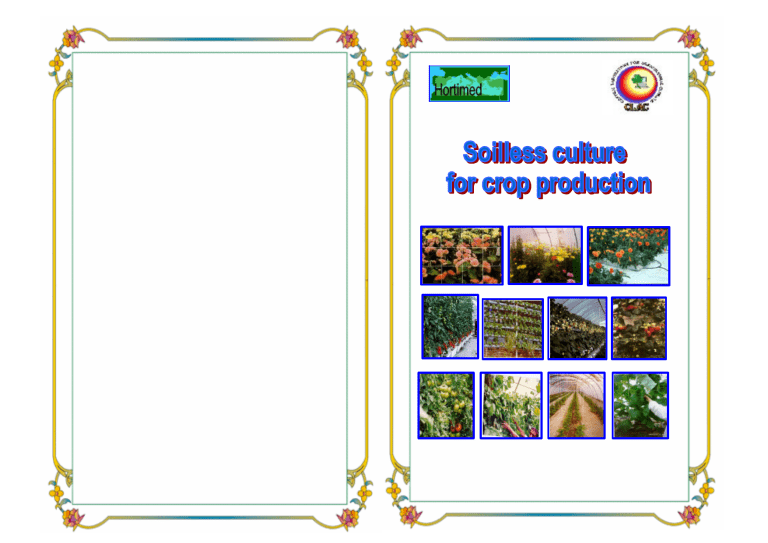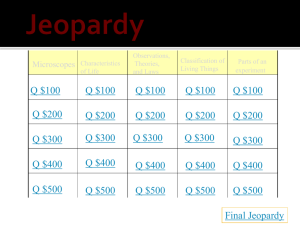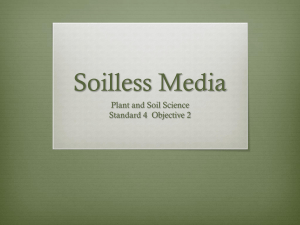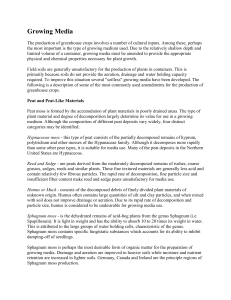D15. Soilless culture for crop production (CLAC)

What is Soilless culture?
Soilless culture is a methods of growing plants without soil.
Why do the grower turn to
Soilless culture?
The difficulty and cost of controlling soilborn pests and diseases.
1.
Soil salinity.
2.
Lack of fertile soil.
3.
Water shortage.
4.
Banding of using Methyl Bromide.
Advantages of Soilless culture?
Soilless culture has many advantages over standard agricultural practices for example:
1.
Weed and soil diseases are not a problem in Soilless culture.
2.
High quality yield.
3.
Cultivating crops in any region even in regions where poor soil conditions prevail.
1
4. Controlling the root environments.
5.increasing water use efficiency.
Soilless cultures fall into two general categories:
?
Substrate culture.
?
Water culture.
Substrate culture is the cultivation of crops in a solid, inert or non-inert medium instead of soil.
Substrate culture can be divided depending into:
1.
Types of drainage system.
2.
Types of substrate
3.
Cultivation methods.
2
Types of drainage systems: -
?
Open system
Excess nutrient solution is allowed to turn to waste.
?
Closed system
Excess nutrient solution is collected, disinfected and recirculated.
Open system
3
Dutch closed growing systems
Mediterranean closed growing systems
4
Types of substrates
There are four functions that substrate must serve in order to support good plant growth: -
1.
It must serve as a reservoir for plant nutrients.
2.
It must hold water in a way that makes it available to the plant.
3.
It must provide plants with gases and water at the same time.
4.
It must support the plant.
Some individual materials (substrates) can provide all four functions, but not at the required level of each. For example, sand provides excellent support and gas exchange but has insufficient water-and nutrient supplying capacity. The coarse particles of sand have small surface area per unit of
5 volume compared to the finer parties of soil
Or peat moss. Since water is held on the surfaces of particles, sand has a small water reserve. Since most nutrients in the sand medium are held in the water films, there is likewise little nutrient reserve.
Soilless substrates can be divided into two groups: -
?
Organic substrates.
?
Inorganic substrates.
Organic Substrates: -
?
Peat moss
Peat moss is formed by the accumulation of plant materials in poorly drained areas. The type of plant material and degrees of decomposition largely determine its value for use in a growing medium.
6
Although the compositions of different peat deposits very widely, four distinec categories may be identified:
1.
Hypanaceous moss.
2.
Reed and Sedge.
3.
Humus or Muck.
4.
Sphagnum moss.
Sphagnum moss is perhaps the most desirable form of organic matter for the preparation of growing media and the
Sphagnum moss is light in weight and has the ability to absorb 10 to 20 times its weight in water. This is attributed to the large groups of water holding cells, characteristic of the genus.
Peat substrate may be used in various ways for raising crops the most popular are bags, modules and troughs, but also in basins, rings, mattresses and bolsters.
7
Peat moss
8
?
Wood Residues
Wood residues constitute a significant source of soilless growing media. These materials are generally bi-products of the lumber industry and are readily available in large quantities. Nitrogen depletion by soil microorganisms, during the decomposition process, is one of the primary problems associated with these materials. However, supplemental applications of N to the growing media can make most wood residues valuable amendments.
?
Sawdust
Several sawdusts, such as walnut and non-composted redwood, are known to have direct phytotoxic effects. However, the C:N ratio of sawdust is such that it is not readily decomposed. The high cellulose and lignin content along with insufficient N supplies creates depletion problems which can
9
Severely restrict plant growth. However supplemental application of nitrogen can reduce this problem.
?
Barks
It is primarily bi-products of the pulp, paper and plywood industries. Suitable particle size is obtained by hammer milling and screening. This produces a material, which is suitable for use in container media.
Physical properties obtained from tree barks are similar to those of Sphagnum moss.
Tomato in organic substrates
10
?
Rice hulls
Rice hulls are a bi-product of the rice milling industry. Although they are extremely light in weight, rice hulls are very effective at improving drainage. The particle size and resistance to decomposition of rice hulls and sawdust are similar. However N depletion is not as serious of a problem in media amended with rice hulls.
Rice Hulls
11
?
Coconut peat
Coconut peat is used for a wide range of soilless crop production throughout the world including: tomato, cucumber, egg plant, capsicum, zucchini, strawberry, melons, carnation, rose, gerbera, gypsophila, lisianthus, chrysanthemum etc. with no harmful environmental impact.
The high water holding capacity of this substrate provides a buffer in high temperatures and high crop load demand without compromising air supply. The presence of organic compounds in Coconut peat can stimulate root growth and offer some natural resistance to plant disease.
12
Coconut peat
13
Coconut peat in boxes
Pepper in Coconut peat
14
Inorganic Substrates: -
?
Perlite
Perlite is a unique volcanic mineral, which expands from four to twenty times its original volume when it is quickly heated to a temperature of approximately 1600-1700º
F. This expansion is due to the presence of two to six percent combined water in the crude perlite rock, which causes the perlite to pop in a manner similar to that of popcorn. When expanded, each granular, snow-white particle of perlite is sterile with a neutral pH and contains many tiny, closed cells or bubbles. The surface of each particle is covered with tiny cavities, which provide an extremely large surface area.
These surfaces hold moisture and nutrients and make them available to plant roots. In addition, because of the physical shape of each particle, air passages are formed which provide optimum aeration and drainage.
Because perlite is sterile, it is free of disease, seeds, and insects.
15
Perlite
Strawberries in perlite horizontal bags
16
?
Sand
Sand is a basic component of soil, ranges in particle size from 0.05mm to
2.0mm in diameter. Fine sands (0.05mm to
0.25mm) do little to improve the physical properties of a growing media and may result in reduced drainage and aeration.
Medium and coarse sand particles are those, which provide optimum adjustments in media texture. Although sand is generally the least expensive of all inorganic amendments it is also the heaviest. This may result in prohibitive transportation costs. Sand is a valuable amendment for both potting and propagation media. But washed sand should be purchased since it is nearly free of clay and organic matter.
17
Sand
Cucumber in sand
18
?
Vermiculite
Vermiculite is a micacious mineral produced by heating to approximately
745ºC.the expanded; plate-like particles, which are formed, have a very high water holding capacity and aid in aeration and drainage. Vermiculite has excellent exchange and buffering capacities as well as
The ability to supply potassium and magnesium. Although vermiculite is less durable than sand and perlite, its chemical and physical properties are very desirable for container media.
Vermiculite
19
?
Calcined clays
Heating montmorrillonitic clay minerals to approximately 690ºC forms calcined clays.
The pottery-like particles formed are six times as heavy as perlite. Calcined clays have a relatively high cation exchange as well as water holding capacity. This material is a vary durable and useful amendment.
Calcined clays
20
?
Pumice
Pumice is direct product of acidic volcanism. Pumice is a highly vesicular volcanic glass, silicic in composition and occurs as massive blocks or unconsolidated, fragmenteted material. The vesicles are glass–walled bubble casts, which give pumice a low density compared to natural glass.
Pumicite, the commercial term for finegrained, fragmented pumice with shards under 2mm in diameter, may be deposited some distance from the source.
Pumice is formed from silicic lavas rich in dissolved volatiles, particularly water vapour. On eruption, sudden release of pressure leads to expansion of volatiles, which, in turn, generates a frothy mass of expelled lava. This mass may solidify on contact with the atmosphere as a vent filling or flow, or may be shattered by a violent eruption. Pumice has many advantages such as high strength-to-weight ratio, insulation and high surface area, which result from the vesicular nature of this rock.
21
Pumice
Different grades of pumice
22
?
Rockwool
Rockwool is manufactured from three natural raw materials: 60% diabase (from of basalt), 20% limestone Rockwool is coke.
Diabase is a rock from which the name
Rockwool is derived. For the preparation of
Rockwool all three materials are melted together at a temperature of 1600
ºC.
The molten mass is then spun at a high speed into thin fibers of 0.005mm diameter, treated with certain additives (a resin) to bind the fibers together and pressed into slabs of various sizes. The most common sizes are 90x30x7.5 cm or 90x20x7.5 cm and recently 90x10x7.5 cm. A part from the growing slabs, Rockwool cubes of 3.0,
4.0 or 5.0 cm sides with a central hole are used for the propagation of seedlings. These are single or group wrapped in polythene or paper. Rockwool is also produced as a loose flock, which is used as a growing medium in pots, in a similar way to peat, or as an additive to other media. On average 95% of the volume of dry Rockwool slab is air space and only 5% is fiber.
23
Rockwool
24
Cucumber in Rockwool slabs
Rockwool cube
25
Tomato in Rockwool slabs
Rockwool cube
26
Cultivation methods in the substrate systems
1-Pots culture
27
2-Boxes culture
3-Troughs culture
28
4-Horizontal bags culture
Cherry tomatoes in Horizontal bags culture
29
5-Vertical bags culture
6-Containers culture
30
7-Hanged column
31
8-Vertical pots
9-Hanged bags
32
Water culture is a section of soilless culture.
On this system, plants cultivated directly in nutrient solution circulated without any substrate.
Water culture divided in two sections: -
?
Static solution culture.
?
Circulated nutrient solution: -
1.
Low technology system.
2.
High technology system.
Definition of NFT
It is a method in a method in which the
Plants have their roots in a shallow stream of recalculating water in which dissolved all the elements required. In this system, nutrient solution circulated, and the root surface is exposed to air.
33
1 - Nutrient film techniques
A - Low technology system
Nutrient solution film
Channel
Nutrient Film Technique
The NFT system is consisted of series parallel troughs laid on a slope from 1% up to 2% in order to grant the constant following of nutrient solution; catchment tank containing the nutrient solution; circulation pump a flow pipe delivering the nutrient solution to the upper part of the troughs and return pipe collecting the solution for return to the catchment tank.
The basic concept of the NFT that the plants roots are not submerged and has access to the air.
34
NFT system consists of: -
?
Catchment tank.
?
Circulating pump.
?
Troughs.
?
Pipes and fittings.
Tank Troughs
Construction of NFT
Catchment tank
The suitable Tanks for use in NFT are manufactured in plastic with large size above
450 liters or polypropylene in smaller size or galvanized tanks can be converted with polythene sheet or use galvanic iron but it must isolate with Epoxy
35
Circulation pump
Direct current pump
Air pump
Pipes and fittings
The suitable pipes for NFT system is made of polyethylene with diameter 32mm or PVC pipe with diameter 1 inch.
36
Troughs
Different materials can be used as a trough in NFT:
?
PVC pipes (4-6 inch).
?
Galvanic iron covered with Epoxy or plastic, which use in high plant density
(A-shape).
?
Wood covered with plastic.
?
Black on white polyethylene sheets
(200mm).
PVC pipes
37
Polyethylene channel
Cantaloupe in NFT system
38
Different types of NFT
(A-shape) system
39
Wood beds covered with plastic
40
Plastic channel in levels
Plant dinesty in NFT
41
Steps of forming troughs
42
Steps of transplanting
NFT cups
Tray Rockwool cubes
43
Cultivating the seedlings
Root mats
44
B- High technology system
High technology Nutrient Film
Technique (NFT)
45
2-Static solution culture
Cultivation in wood beds
Water pole
46
Other types of water culture
?
Static Aerated Technique (SAT)
Plants are grown in a deep static nutrient solution which is aerated either by pumping air into the nutrient solution in the tank.
?
Ebb and Flow Technique (EFT)
Plants are grown as in SAT, but the nutrient solution is drained off 3-4 times a day to permit the roots to respire. This technique is called "Flood and Drain" technique.
47
?
Deep Flow Technique (DFT)
A deep of nutrient solution (several inches deep) is circulated around the roots by a
pump and drain by gravity. This system is ideal for leafy crops.
?
Aerated Flow Technique (AFT)
A modified version of DFT. where, the nutrient solution is profusely aerated by special mechanisms. The Japanese "Kyowa Hyponicxa
Technique" is somewhat similar to AFT.
Excellent for growing both leafy and fruit crops.
48





